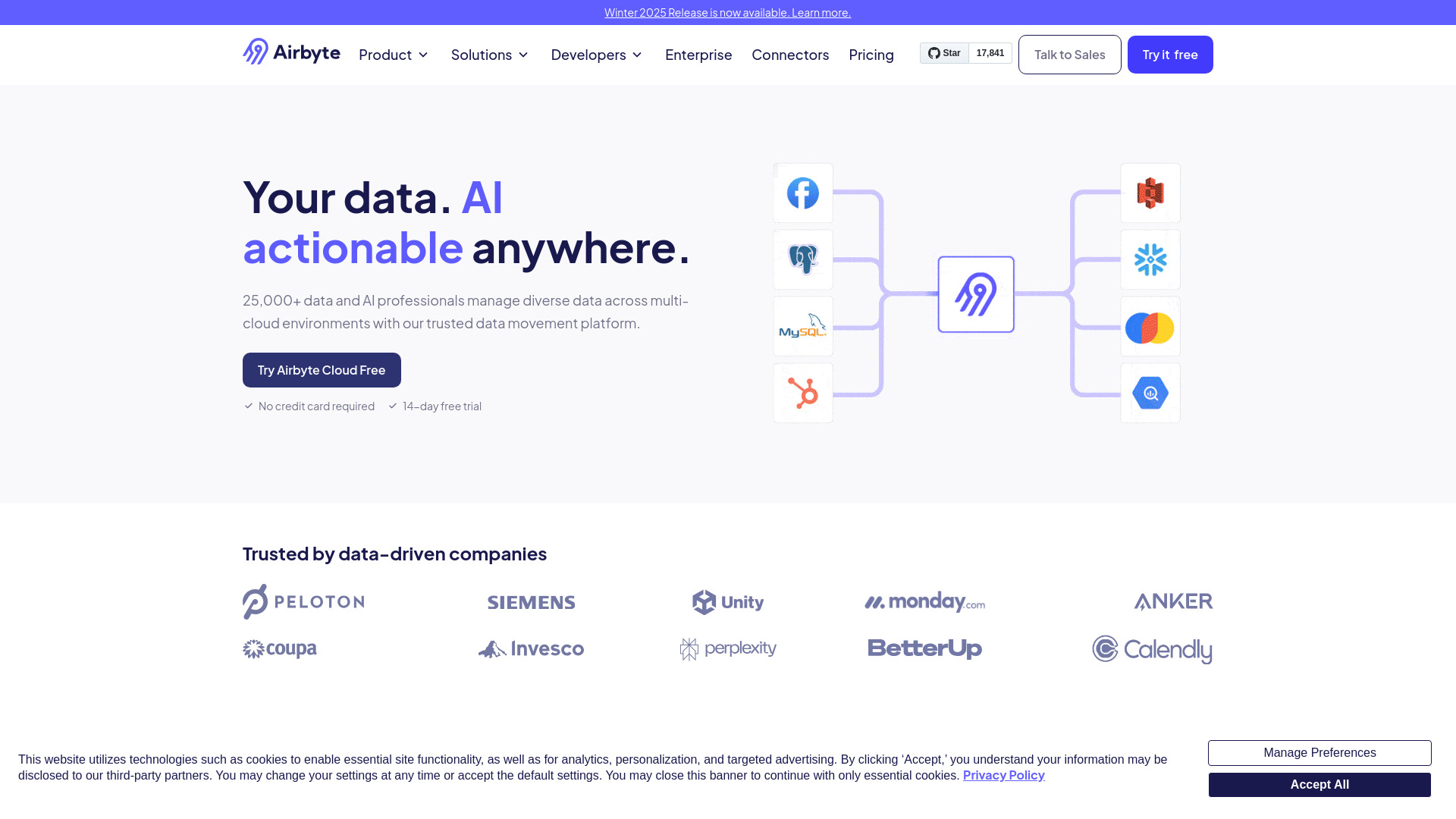- Home
- AI Developer Tools
- Airbyte

Airbyte
Open Website-
Tool Introduction:Open-source ELT for data integration: easy connectors, secure syncs, AI data
-
Inclusion Date:Oct 21, 2025
-
Social Media & Email:
Tool Information
What is Airbyte
Airbyte is an open-source data integration and ELT platform built to replicate databases and APIs at scale and deliver analytics- and AI/LLM-ready data to warehouses, data lakes, and vector stores. It streamlines extraction, loading, and optional transformation, while handling incremental syncs and schema drift. With hundreds of prebuilt connectors and a developer-friendly SDK, teams can standardize pipelines and even embed connectors into their own products. Airbyte supports self-hosted, cloud, and hybrid deployments to meet security and governance needs.
Airbyte Main Features
- Open-source ELT framework: Flexible, extensible architecture with a rich connector catalog and a Python/Java SDK to build new sources and destinations fast.
- Database and API replication: Reliable syncs from relational databases, SaaS APIs, files, and event streams to modern data warehouses and lakes.
- Incremental and CDC modes: Support for incremental extraction and change data capture to reduce load, costs, and latency.
- AI & LLM data readiness: Route structured and unstructured data to vector databases and other AI infrastructure for RAG and fine-tuning workflows.
- Transformations with dbt/SQL: Optional normalization and post-load transformations to standardize schemas and improve downstream analytics.
- Schema drift management: Automatic handling and alerts for column additions, removals, and type changes.
- Monitoring and reliability: Job-level logging, retries, and alerts to keep pipelines observable and resilient.
- Deploy anywhere: Self-hosted (Docker/Kubernetes), fully managed cloud, or hybrid with data plane in your VPC for enhanced governance.
- Embedded connectors: Add secure data import flows inside your product with Airbyte Embedded, reducing custom integration work.
Who Should Use Airbyte
Airbyte suits data engineers, analytics engineers, and platform teams who need scalable ELT pipelines across databases and APIs. it's also a strong fit for ML/AI teams building RAG or feature pipelines, SaaS product teams embedding user data imports, and enterprises requiring hybrid deployment for compliance and data residency.
How to Use Airbyte
- Choose a deployment: self-hosted, managed cloud, or hybrid based on security and networking needs.
- Create a source (e.g., PostgreSQL, Salesforce, S3) and a destination (e.g., BigQuery, Snowflake, Databricks, vector DB).
- Authenticate connections and run connectivity checks.
- Select a sync mode: full refresh, incremental, or CDC if supported by the source.
- Configure frequency and resource settings; enable normalization or dbt-based transformations if needed.
- Map streams and fields, define primary keys and cursors, and set conflict handling rules.
- Run the initial sync and monitor logs, metrics, and alerts.
- Schedule recurring jobs and manage schema changes as sources evolve.
- Integrate with orchestration or CI/CD for automated, versioned deployments.
Airbyte Industry Use Cases
- E-commerce analytics: Replicate orders, product, and marketing data from multiple SaaS tools into a warehouse for unified reporting and attribution.
- Financial services CDC: Stream changes from OLTP databases to a lakehouse for near-real-time dashboards and audit trails.
- AI/LLM pipelines: Sync documents and events to a vector database to power retrieval-augmented generation and agent memory.
- SaaS data onboarding: Embed connectors to import customers’ data securely into your application without building dozens of custom integrations.
Airbyte Pricing
Airbyte offers a free, open-source edition for self-hosted deployments. Airbyte Cloud provides a fully managed service with usage-based pricing and typically includes a free tier or trial to get started. Enterprise plans are available for advanced governance, security, and support, with pricing provided on request.
Airbyte Pros and Cons
Pros:
- Open-source and extensible with a large connector ecosystem and robust SDK.
- Supports database and API replication with incremental and CDC options.
- Flexible deployments: self-hosted, cloud, and hybrid for governance and compliance.
- AI-friendly destinations, including vector databases for LLM use cases.
- Solid observability, retries, and schema drift handling.
Cons:
- Self-hosted setups require infrastructure management and on-call ownership.
- Building and maintaining custom connectors may demand engineering effort.
- Near-real-time needs may require careful tuning and CDC expertise.
- Usage costs in managed cloud can grow with high-volume or high-frequency syncs.
Airbyte FAQs
-
What is the difference between Airbyte Open Source and Airbyte Cloud?
Open Source is self-managed and free to run; Cloud is fully managed with automated scaling, maintenance, and support, billed on usage.
-
Does Airbyte support change data capture (CDC)?
Yes. For supported databases, Airbyte can capture and replicate row-level changes to reduce latency and load.
-
Can I use Airbyte for LLM/RAG pipelines?
Yes. You can sync text and metadata to vector databases and prepare AI-ready datasets for retrieval-augmented generation.
-
How do I build a custom connector?
Use the Airbyte Connector Development Kit (CDK) to implement source or destination logic, run tests locally, and publish for reuse.
-
Is a hybrid deployment possible?
Yes. You can keep the data plane within your own network while using managed control services to balance security and convenience.




